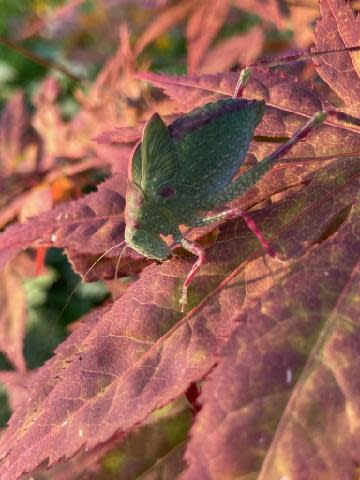Over the Garden Fence: Where did the katydids go?
The killing frost means that the life cycle of many insects has come to an end. It is so with the katydid.
A katydid is really just a "long-horned" grasshopper or a "bush cricket." Crickets, grasshoppers and katydids are all part of the order Orthoptera. That means an ability to chew. And chew they do. Katydids are one of 6,000 predominantly nocturnal insects related to this order. This is not to say the critters are not busy in the daytime.
The neat thing, or interesting thing, is that most of them resemble a leaf. This helps them blend in with vegetation which hides them from predators. Many do have markings on the green wings that helps them blend into other foliage.
On the menu for katydids are leaves. They munch on stems if leaves are not available, fruit pulp of apricots, plums, pears and citrus fruit. They don't dig so roots are not eaten. They are fond of aphids and will dine on dead insects. They are not considered garden pests because of the varied diet.

In the past summer season when they were most active, only one came through my life. Oddly, the one photographed in our yard was showing off on a Japanese maple leaf. There was no notion of camouflage that July afternoon in sunshine. The long antennae and leaf-like wings were readily seen. Long back legs help them leap. They actually rub the front wings together to make a loud sound "ka-ty-did." Wings are used to communicate for territorial, defensive and reproductive purposes.
They seem gentle. If they were to pinch you, it would not break the skin.
Katydids are active at night when they use their wings to produce a rhythmic staccato rasping. Often this is a chorus broadcast managed by a group of males who are actually luring in females. The chirping signals are the first step in creating the next season's leafy green katydids.
After mating takes place oval, gray eggs are laid upon leaves, stems and even on the ground. The eggs remain in place dormant throughout the coming winter to hatch in the spring. In spring, the eggs hatch and without wings continue life going through five molts. Once wings appear it is an official adult.
As the killing frost clobbers so much of the remnants of summer, the life cycle of the adult katydid has come to an end. Never fear — somewhere in our yards katydid eggs await the arrival of spring.
Mary Lee Minor is a member of the Earth, Wind and Flowers Garden Club, an accredited master gardener, a flower show judge for the Ohio Association of Garden Clubs and a former sixth grade teacher.
This article originally appeared on Bucyrus Telegraph-Forum: All about katydids and their life cycle
